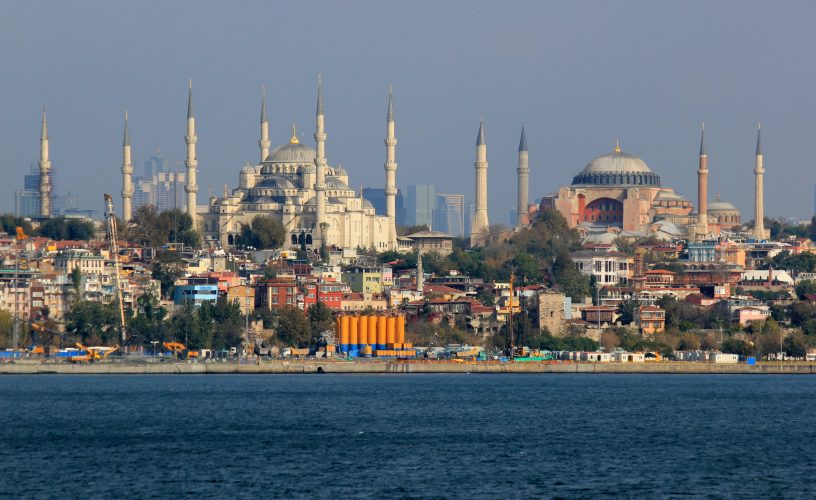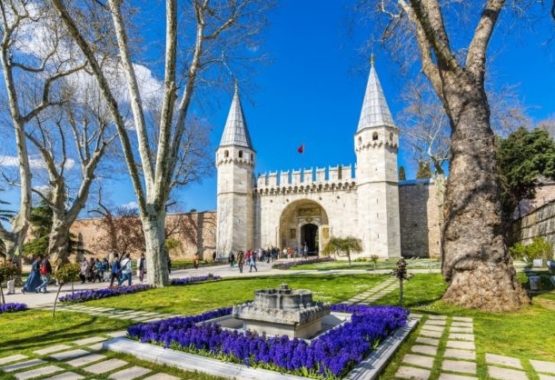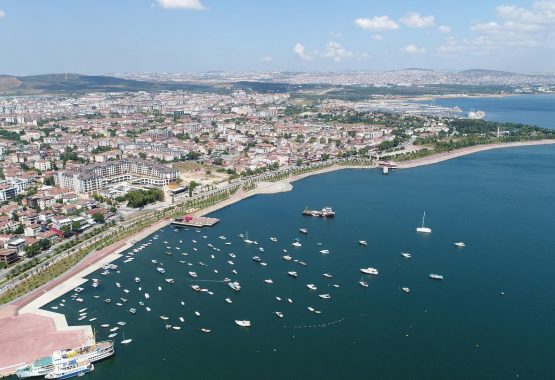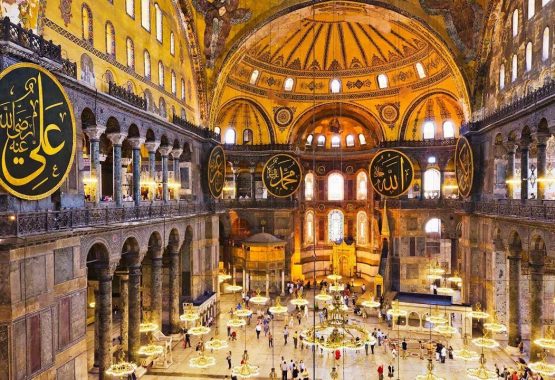SULTANAHMET CAMİİ (BLUE MOSQUE)
About Blue Mosque
The Blue Mosque (Called Sultanahmet Camii in Turkish) is an historical mosque in Istanbul. The mosque is known as the Blue Mosque because of blue tiles surrounding the walls of interior design.Mosque was built between 1609 and 1616 years, during the rule of Ahmed I. just like many other mosques, it also comprises a tomb of the founder, a madrasa and a hospice. Besides still used as a mosque, the Sultan Ahmed Mosque has also become a popular tourist attraction in Istanbul.
Besides being tourist attraction, it’s also a active mosque, so it’s closed to non worshippers for a half hour or so during the five daily prayer.
Best way to see great architecture of the Blue Mosque is to approach it from the Hippodrome. (West side of the mosque) As if you are non-Muslim visitor, you also have to use same direction to enter the Mosque.
Architectural
The Sultan Ahmed Mosque has five main domes, six minarets, and eight secondary domes. The design is the culmination of two centuries of Ottoman mosque development. It incorporates some Byzantine Christian elements of the neighboring Hagia Sophia with traditional Islamic architecture and is considered to be the last great mosque of the classical period. The architect, Sedefkâr Mehmed Ağa, synthesized the ideas of his master Sinan, aiming for overwhelming size, majesty and splendour. It has a forecourt and special area for ablution. In the middle it has a big fountain. On the upper side it has a big chain. The upper area is made up of 20000 ceramic tiles each having 60 tulip designs. In the lower area it has 200 stained glass windows.
At its lower levels and at every pier, the interior of the mosque is lined with more than 20,000 handmade İznik style ceramic tiles, made at İznik (the ancient Nicaea) in more than fifty different tulip designs. The tiles at lower levels are traditional in design, while at gallery level their design becomes flamboyant with representations of flowers, fruit and cypresses. The tiles were made under the supervision of the Iznik master. The price to be paid for each tile was fixed by the sultan’s decree, while tile prices in general increased over time.
TOPKAPI PALACE
The Topkapi Palace is the biggest and one of the most popular sites to visit in Istanbul. Walking up to the gatehouse of the Topkapi palace is unimpressive, yet behind the stone walls originally built more than 500 years ago, is a staggering collections of courtyards, rooms, and imperial places that portray the varied and certainly colourful life of the Ottoman sultans and their entourage.
Having invaded Constantinople in 1453, Topkapi Palace was the first home for the Ottoman Sultans, used until the beginning of the 20th century when it was abandoned in favour of the newly built Dolmabahce Palace which showcased western architectural themes of that time.
It was built in between 1466 and 1478 by the sultan Mehmet II on top of a hill in a small peninsula, dominating the Golden Horn to the north, the Sea of Marmara to the south, and the Bosphorus strait to the north east, with great views of the Asian side as well. The palace was the political center of the Ottoman Empire between the 15th and 19th centuries, until they built Dolmabahce Palace by the waterside.
After the Conquest of Constantinople in 1453, Mehmet II ordered to built his palace in its present location on top of the ancient Byzantine ruins, meanwhile he spent some time during its construction at a smaller palace where there is the University of Istanbul today, in Bayezit square. Once they moved to Topkapi palace, the old one was called as “Old Palace” and Topkapi as the “New Palace”. But local people called it as “Topkapi” which in Turkish means “Gate of Cannons” because of huge cannons displayed outside of its gates, those which were used during the Conquest.
These days, the palace is an extensive museum holding artefacts and relics. Visitors walk around kitchens that cooked food for more than 10,000 people, they pass through the highly ceremonial circumcision rooms; they view the extensive armoury and also get an insight into the clothes and jewels worn by Sultans, their wives, children and servants. The section that usually garners the most admiration though is the Harem.
HAREM
At Topkapı Palace, the Harem Apartments were where the sultans lived together with their families. Reflecting architectural styles ranging from the 16th century to the early 19th century, the entire complex is of the greatest importance in terms of architectural history. The Harem was initially established within the Second Courtyard above the palace’s back gardens and expanded greatly over the centuries. Soon after Topkapı Palace was constructed, the Old Palace (located in the Bayezid neighborhood of Istanbul) began to be used solely as the harem, while Topkapı Palace became the seat of government and of public functions (which together were called “selamlık”). However, there are also some sources stating that, during this same period, a small harem, the Girls’ Palace (Sarây-ı Duhterân), was also built beside the palace’s Golden Road. The Harem contains more than 300 rooms, nine bathhouses, two mosques, a hospital, dormitories, and a laundry. The basic plan of the Harem consists of consecutive courtyards surrounded by and interspersed with living quarters, rooms, pavilions, and service buildings.
As soon as you get in you will be overwhelmed by the beauty of all the bright colored mosaics and tiles. But there’s more! The further you’ll go, the more gorgeous the rooms become. All these golden details, the use of colors, the curls, the stained glass windows, the texts of the Koran in marble and gold,… it is all perfect. The second time I visited the Harem, I had the place to myself. No one else was there except the guards! I took so many pictures! I easily spend about 2 hours at the Harem and about an hour to visit the other parts of Topkapi.
HAGİA SOPHİA
Hagia Sophia, Turkish Ayasofya, Latin Sancta Sophia, also called Church of the Holy Wisdom or Church of the Divine Wisdom, cathedral built at Constantinople (now Istanbul, Turkey) in the 6th century CE (532–537) under the direction of the Byzantine emperor Justinian I. By general consensus, it is the most important Byzantine structure and one of the world’s great monuments.
The Hagia Sophia is an enormous architectural marvel in Istanbul, Turkey, that was originally built as a Christian basilica nearly 1,500 years ago. Much like the Eiffel Tower in Paris or the Parthenon in Athens, the Hagia Sophia is a long-enduring symbol of the cosmopolitan city. However, as notable as the structure is itself, its role in the history of Istanbul—and, for that matter, the world—is also significant and touches upon matters related to international politics, religion, art and architecture.
The Hagia Sophia anchors the Old City of Istanbul and has served for centuries as a landmark for both Orthodox Christians and Muslims, as its significance has shifted with that of the dominant culture in the Turkish city.
The structure that stands today was actually the third church to be built on this site. The first two (built in AD 360 and Ad 415 respectively) were both razed to the ground in troubled Byzantine times. Emperor Justinian commissioned the current building in the sixth century as a Greek Orthodox Church that would outdo the Temple of Solomon in Jerusalem. It took just five years and the manpower of nearly 11,000 people to erect the structure that was the largest Christian church in the world for nearly a thousand years. In 1204, the Crusaders displaced the Patriarch of Constantinople with a Latin bishop, which is why much of its original relics can now be found in St. Mark’s Basillica in Venice.
The first Hagia Sophia featured a wooden roof. The structure was burned to the ground in 404 A.D. during the riots that occurred in Constantinople as a result of political conflicts within the family of then-Emperor Arkadios, who had a tumultuous reign from 395 to 408 A.D.
Arkadios’ successor, Emperor Theodosios II, rebuilt the Hagia Sophia, and the new structure was completed in 415. The second Hagia Sophia contained five naves and a monumental entrance and was also covered by a wooden roof.
However, a little more than one century later, this would again prove to be a fatal flaw for this important basilica of the Greek Orthodox faith, as the structure was burned for a second time during the so-called “Nika revolts” against Emperor Justinian, who ruled from 527 to 565.
Unable to repair the damage caused by the fire, Justinian ordered the demolition of the Hagia Sophia in 532. He commissioned renowned architects Isidoros (Milet) and Anthemios (Tralles) to build a new basilica.
The third Hagia Sophia was completed in 537, and it remains standing today.
The first religious services in the “new” Hagia Sophia were held on December 27, 537. At the time, Emperor Justinian is reported to have said, “My Lord, thank you for giving me the chance to create such a worshipping place.”






